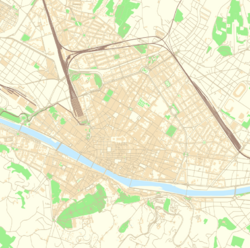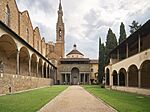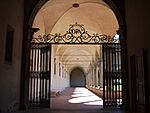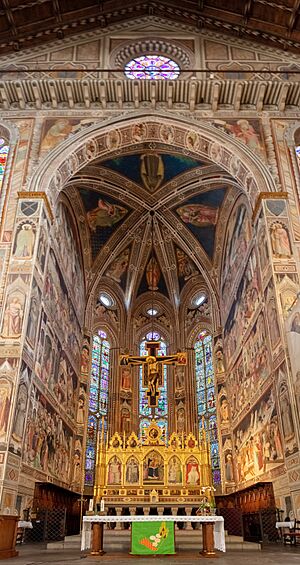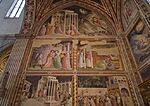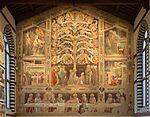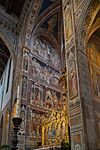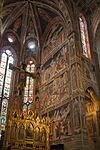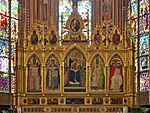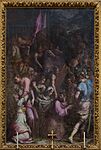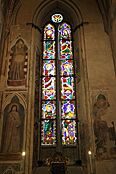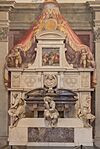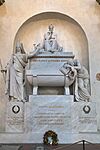Santa Croce, Florence facts for kids
Quick facts for kids Basilica of the Holy Cross |
|
|---|---|
|
Basilica di Santa Croce (Italian)
|
|
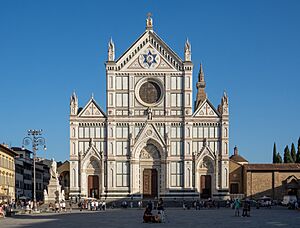
Façade of Santa Croce, October 2023
|
|
| 43°46′6.3″N 11°15′45.8″E / 43.768417°N 11.262722°E | |
| Location | Florence, Tuscany |
| Country | Italy |
| Denomination | Catholic Church |
| Religious order | Order of Friars Minor |
| History | |
| Status | Minor basilica Conventual church |
| Consecrated | 1443 |
| Architecture | |
| Architectural type | Church |
| Style | Gothic, Renaissance, Gothic Revival |
| Groundbreaking | 1294–1295 |
| Completed | 1385 |
| Administration | |
| Archdiocese | Archdiocese of Florence |
The Basilica di Santa Croce is a very important church in Florence, Italy. Its name means 'Basilica of the Holy Cross' in Italian. It is the main church for the Franciscan religious group in Florence.
You can find it in the Piazza di Santa Croce, which is about 800 meters southeast of the famous Duomo. This area used to be marshland outside the city walls. Many famous Italians are buried or honored here. These include important figures from the Italian Renaissance like Michelangelo, Galileo, and Machiavelli. Because of all these famous people, it is also known as the Temple of the Italian Glories.
Contents
About the Building
The Basilica of Santa Croce is the largest Franciscan church in the world. It has sixteen chapels inside. Many of these chapels are decorated with beautiful frescoes. These paintings were made by Giotto and his students. The church also has many tombs and memorials for famous people.
Legend says that Saint Francis himself founded Santa Croce. The church you see today replaced an older building. Construction started on May 12, 1294. Wealthy families in Florence helped pay for it. The church was officially opened in 1442 by Pope Eugene IV. Its design is simple and plain, which matches the style of the Franciscans.
The church is shaped like a "Tau cross," which is a symbol of Saint Francis. It is 115 meters long. It has a main hall (nave) and two side aisles. These are separated by rows of eight-sided columns. There was also a convent next to the church. Some of those buildings are still there today.
Important Areas and Changes
The main cloister (a covered walkway around a courtyard) is called the Primo Chiostro. Here you will find the Cappella dei Pazzi. This chapel was finished in the 1470s. Filippo Brunelleschi, who designed the Duomo's dome, helped design it. The chapel's design is very simple and elegant.
In 1560, some parts of the church were changed. This was part of a movement called the Counter-Reformation. The screen that separated the choir was removed. The inside of this area was rebuilt by Giorgio Vasari. These changes unfortunately damaged some of the church's decorations. Many altars that were on the screen were lost.
For example, the Bardi Chapel had frescoes showing the life of Saint Francis. These were covered with plaster. Vasari then placed new altars against the walls. This caused a lot of damage to the old frescoes.
The church's bell tower was built in 1842. It replaced an older one that was hit by lightning. The beautiful marble front (façade) was added between 1857 and 1863. This new style is called neo-Gothic. A Jewish architect named Niccolò Matas designed the façade. He included a Star of David in his design. Matas wanted to be buried with his friends. But because he was Jewish, he was buried under the church's entrance. He was honored with an inscription there.
In 1866, the church and its buildings became public property. This happened after wars that led to Italy becoming one country.
During the 1800s, the Bardi Chapel was restored. The 16th-century altars and plaster were removed. This revealed Giotto's frescoes of the Life of St. Francis. One famous painting is the Death of St. Francis. Parts of this painting were missing where an altar had been. It was heavily restored in the 19th century. Later, these newer restorations were removed. This showed only the parts that were truly Giotto's original work.
The Museum of Santa Croce (Museo dell'Opera di Santa Croce) is mostly in the refectory (dining hall). This is also off the cloister. There is a monument to Florence Nightingale in the cloister. She was born in Florence and named after the city. Brunelleschi also built the inner cloister, which was finished in 1453.
In 1940, during World War II, many artworks were hidden for safety. A man named Ugo Procacci noticed a painting called the Badia Polyptych being moved. He realized it had been taken from another church, the Badia Fiorentina, during the time of Napoleon. It had accidentally been put in Santa Croce. Later, between 1958 and 1961, an artist named Leonetto Tintori carefully removed layers of paint from Giotto's Peruzzi Chapel scenes. This revealed Giotto's original artwork.
In 1966, the Arno River flooded Florence. Santa Croce was badly affected. Water, mud, and oil entered the church. The damage to the buildings and art was very serious. It took many decades to repair everything.
Today, the old dormitory where the Franciscan friars slept is home to the Scuola del Cuoio (Leather School). Visitors can watch artisans make purses, wallets, and other leather items. These are sold in the shop next door.
Restoration Efforts
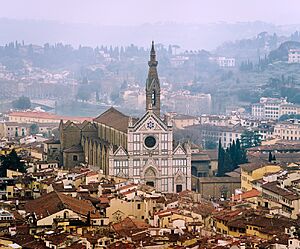
The basilica has been undergoing a long restoration project. Italy's civil protection agency has been helping. On October 20, 2017, the church was temporarily closed. This happened after some masonry fell, sadly causing the death of a tourist. The church was closed so its stability could be checked. An investigation was started to find out how this happened.
Amazing Artworks
Many famous artists have their work in Santa Croce. Here are some of them:
- Benedetto da Maiano: He made the pulpit. With his brother Giuliano, he made the doors to the Pazzi Chapel.
- Cimabue: His Crucifix was badly damaged by the 1966 flood. It is now in the refectory.
- Andrea della Robbia: He created an altarpiece in the Medici Chapel.
- Luca della Robbia: He made the glazed terracotta decorations in the Pazzi Chapel.
- Desiderio da Settignano: He created a frieze in the Pazzi Chapel.
- Donatello: You can see his Cavalcanti Annunciation on the south wall. He also made a crucifix in the Bardi di Vernio Chapel. His St Louis of Toulouse is in the refectory.
- Agnolo Gaddi: He painted the fresco cycle called The Legend of the True Cross in the apse (1385–1387). He also designed the stained glass windows there. He painted frescoes in the Cappella Castellani. These show scenes from the lives of saints like Anthony the Great and Nicholas.
- Taddeo Gaddi: He painted frescoes in the Baroncelli Chapel. His Crucifixion is in the sacristy. His Arbor vitae with the Last Supper (around 1330–40 or –60) in the refectory is considered his best work.
- Giotto: He painted frescoes in the Peruzzi Chapel and the Bardi Chapel. He might have also painted the Coronation of the Virgin altarpiece in the Baroncelli Chapel.
- Giovanni da Milano: He painted frescoes in the Rinuccini Chapel. These show scenes from the Life of the Virgin and the Magdalen.
- Maso di Banco: He painted frescoes in the Bardi di Vernio Chapel (1335–1338). These show scenes from the life of St. Sylvester.
- Henry Moore: He created a statue of a warrior in the Primo Chiostro.
- Andrea Orcagna: Most of his frescoes disappeared when Vasari remodeled the church. But some pieces remain in the refectory.
- Antonio Rossellino: He made a relief sculpture called the Madonna del Latte (1478) in the south aisle.
- Santi di Tito: He painted Supper at Emmaus and Resurrection altarpieces in the north aisle.
- Giorgio Vasari: He painted Way to Calvary.
- Domenico Veneziano: He painted SS John and Francis in the refectory.
Some other important artworks that were once in Santa Croce are now in other museums. For example, a polyptych by Lorenzo di Niccolò is now split between Florentine Galleries and the Bagatti Valsecchi Museum. The Novitiate Altarpiece by Filippo Lippi was painted for the church's Novitiate Chapel.
Beautiful Stained-Glass Windows
Santa Croce also has some of the oldest stained-glass windows in Florence. In medieval Italy, a painter would usually design these windows. Then, a glazier (a skilled artist who makes stained glass) would create them. Many of the private chapels in the church's transept (the part that crosses the main body of the church) have well-preserved windows from the late 1200s and 1300s. There are also some examples of stained glass from the 1800s and 1900s in Santa Croce.
-
A stained glass roundel showing Elijah in the Fiery Chariot. Designed by Taddeo Gaddi.
-
A window showing the family tree of the Virgin Mary. Made around 1320-25.
Tombs of Famous Italians
Santa Croce became a very popular church for the people of Florence. It became a tradition for important Florentines to be buried or remembered here. Some were buried in chapels owned by rich families like the Bardi and Peruzzi. Over time, famous Italians from other places were also honored here. For 500 years, monuments have been built in the church for many notable people, including:
- Leon Battista Alberti (a famous architect and artist from the 1400s)
- Vittorio Alfieri (a poet and writer from the 1700s)
- Eugenio Barsanti (who helped invent the internal combustion engine)
- Leonardo Bruni (a scholar and historian from the 1400s)
- Dante (a famous poet, though he is buried in Ravenna)
- Ugo Foscolo (a poet from the 1800s)
- Galileo Galilei (the famous scientist)
- Giovanni Gentile (a philosopher from the 1900s)
- Lorenzo Ghiberti (a famous artist who worked with bronze)
- Niccolò Machiavelli (a political thinker)
- Carlo Marsuppini (a leader of Florence in the 1400s)
- Michelangelo Buonarroti (the famous artist and sculptor)
- Gioachino Rossini (a famous composer)
- Guglielmo Marconi (the inventor, though he is buried near Bologna)
- Enrico Fermi (a nuclear physicist, only a memorial here as he is buried in Chicago)
Monuments in the Cloister
- Florence Nightingale (the famous nurse)
Santa Croce in Books
The Basilica of Santa Croce has appeared in several famous books:
- Romola (1863) by George Eliot
- A Room with a View (1908) by E.M. Forster
- Hannibal (1999) by Thomas Harris
See also
 In Spanish: Basílica de la Santa Cruz (Florencia) para niños
In Spanish: Basílica de la Santa Cruz (Florencia) para niños
- History of medieval Arabic and Western European domes
- History of Italian Renaissance domes
- History of early modern period domes


